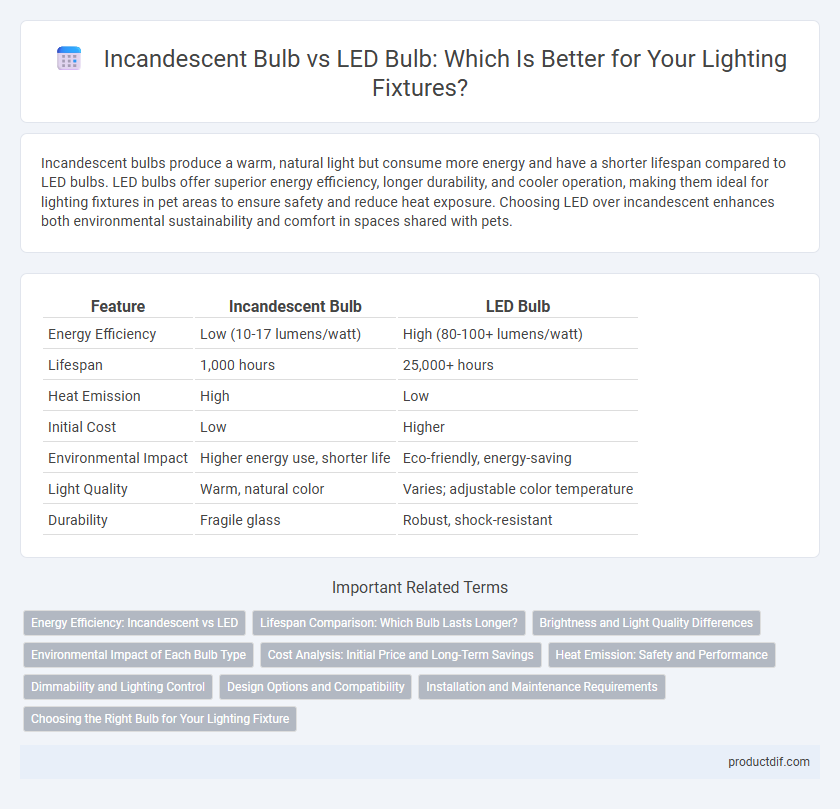Incandescent bulbs produce a warm, natural light but consume more energy and have a shorter lifespan compared to LED bulbs. LED bulbs offer superior energy efficiency, longer durability, and cooler operation, making them ideal for lighting fixtures in pet areas to ensure safety and reduce heat exposure. Choosing LED over incandescent enhances both environmental sustainability and comfort in spaces shared with pets.
Table of Comparison
| Feature | Incandescent Bulb | LED Bulb |
|---|---|---|
| Energy Efficiency | Low (10-17 lumens/watt) | High (80-100+ lumens/watt) |
| Lifespan | 1,000 hours | 25,000+ hours |
| Heat Emission | High | Low |
| Initial Cost | Low | Higher |
| Environmental Impact | Higher energy use, shorter life | Eco-friendly, energy-saving |
| Light Quality | Warm, natural color | Varies; adjustable color temperature |
| Durability | Fragile glass | Robust, shock-resistant |
Energy Efficiency: Incandescent vs LED
Incandescent bulbs consume significantly more energy compared to LED bulbs, with incandescent models using about 60 watts to produce the same light output that a 10-watt LED bulb can generate. LED bulbs convert up to 90% of energy into light, whereas incandescent bulbs waste approximately 90% of energy as heat. Switching to LED lighting fixtures can reduce electricity consumption by up to 80%, resulting in substantial energy savings and lower utility bills.
Lifespan Comparison: Which Bulb Lasts Longer?
LED bulbs typically last between 15,000 to 25,000 hours, significantly outlasting incandescent bulbs, which average around 1,000 to 2,000 hours. The extended lifespan of LED bulbs translates to lower replacement frequency and reduced maintenance costs for lighting fixtures. Choosing LED lighting offers better durability and energy efficiency compared to traditional incandescent bulbs.
Brightness and Light Quality Differences
Incandescent bulbs produce a warm, yellowish light with a color temperature of around 2700K, offering excellent color rendering with a CRI of 100 but lower brightness efficiency at approximately 15 lumens per watt. LED bulbs provide a broader range of color temperatures from 2700K to 6500K, delivering higher brightness efficiency up to 100 lumens per watt while maintaining high color rendering indexes typically above 80. The light quality of LEDs is more versatile and energy-efficient, producing less heat and longer lifespan compared to incandescent bulbs, making them preferable for diverse lighting applications.
Environmental Impact of Each Bulb Type
Incandescent bulbs consume significantly more energy, producing around 90% of their energy as heat, which increases carbon emissions and accelerates environmental degradation. LED bulbs, by contrast, use up to 80% less energy and have a longer lifespan, reducing waste and lowering greenhouse gas emissions over time. The reduced energy consumption of LEDs directly contributes to decreased fossil fuel dependence and less air pollution, making them a more sustainable lighting choice.
Cost Analysis: Initial Price and Long-Term Savings
Incandescent bulbs have a lower initial purchase price, typically ranging from $0.50 to $2 per bulb, but they consume more energy, resulting in higher electricity costs over time. LED bulbs, while more expensive upfront at $3 to $10 per bulb, offer significant long-term savings due to their energy efficiency, using up to 75% less electricity and lasting 25 times longer than incandescent bulbs. Over the lifespan of a single LED bulb, consumers can save approximately $80 to $100 in energy and replacement costs compared to incandescent lighting.
Heat Emission: Safety and Performance
Incandescent bulbs emit significantly more heat than LED bulbs, converting only about 10% of energy into light while the rest dissipates as heat, which increases fire hazard risks and reduces energy efficiency. LED bulbs operate at much lower temperatures, enhancing safety in enclosed or heat-sensitive fixtures and improving overall performance by maintaining stable light output without overheating. This reduced heat emission extends the lifespan of both the bulb and surrounding components, making LEDs a superior choice for efficient, safe lighting solutions.
Dimmability and Lighting Control
Incandescent bulbs offer smooth dimming capabilities due to their simple resistive filament, allowing for precise lighting control with standard dimmer switches. LED bulbs require compatible dimmers designed for low-wattage electronics to avoid flickering or reduced dimming range, though advancements in LED driver technology have significantly improved their dimmability performance. Optimizing lighting control with LEDs enhances energy efficiency and lifespan while providing customizable ambiance for residential and commercial environments.
Design Options and Compatibility
LED bulbs offer a wide range of design options, including various shapes, sizes, and color temperatures, making them highly versatile for different lighting fixtures. Incandescent bulbs typically come in fewer design variations but are compatible with most traditional fixtures without requiring modifications. Compatibility with dimmer switches and smart lighting systems is generally better with LED bulbs, enhancing their adaptability in modern lighting designs.
Installation and Maintenance Requirements
Incandescent bulbs require simple installation with standard sockets but demand frequent replacements due to shorter lifespans, increasing maintenance efforts. LED bulbs offer more complex initial setup in some cases, especially with dimmers or smart systems, but provide extended durability and minimal maintenance needs over time. Choosing LED bulbs significantly reduces long-term service interruptions and costs associated with bulb replacements.
Choosing the Right Bulb for Your Lighting Fixture
Incandescent bulbs consume significantly more energy and have shorter lifespans compared to LED bulbs, which offer superior energy efficiency and longevity. LED bulbs produce less heat, making them safer for enclosed or heat-sensitive lighting fixtures, while incandescent bulbs generate warmth that can affect fixture materials. When choosing the right bulb, consider the fixture's wattage rating, desired brightness measured in lumens, and color temperature to ensure optimal performance and energy savings.
Incandescent bulb vs LED bulb Infographic

 productdif.com
productdif.com